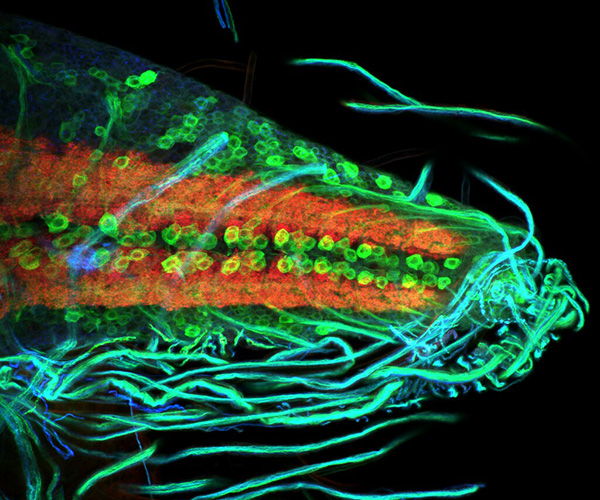
Ventral cord from Drosophila larva.
Credit: Rosario Vicidomini, Serpe Lab
The nervous system is strikingly complex, with diverse cell types working in concert to perform various tasks. A tightly regulated division of labor ensures that the nervous system functions properly. However, much remains to be learned about the different cell types and their contributions.
To fill these knowledge gaps, the Serpe Lab characterized the ventral nerve cord (VNC) of fruit fly larvae, which shares many features with the vertebrate spinal cord. Using a single-cell RNA sequencing (scRNA-seq) approach, they created a comprehensive atlas of larval VNC cell types. Their dataset captures primary larval neurons and glia, as well as neuronal precursors and immature adult neurons, organized into a developing trajectory.
- The study offers key insights into the processes by which the adult VNC is generated. For example, scRNA-seq revealed that 60% of larval VNC neurons are future cells of the adult fly. These immature neurons remain dormant at the larval stage.
- The scientists also describe highly diverse, distinct subtypes of larval interneurons, which transmit information within the central nervous system, and glia.
- The work offers an in-depth characterization of all the different subtypes of motor neurons, which convey information from the brain and sensory systems to specific muscles using a constellation of synaptic receptors—the proteins that recognize and respond to neurotransmitters and neuropeptides.
- Overall, the atlas offers an extensive resource to the research community and promises to aid future discoveries of the cellular and molecular mechanisms underlying nervous system function.
Reference
Nguyen TH, Vicidomini R, Choudhury SD, Han TH, Maric D, Brody T, Serpe M. scRNA-seq data from the larval Drosophila ventral cord provides a resource for studying motor systems function and development. Dev Cell DOI: 10.1016/j.devcel.2024.03.016 (2024)
Learn more about the Cell Regulation and Development Affinity Group: https://www.nichd.nih.gov/about/org/dir/affinity-groups/CRD
 BACK TO TOP
BACK TO TOP